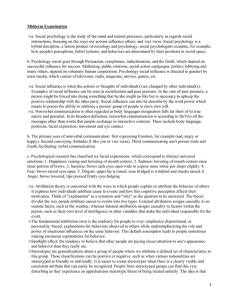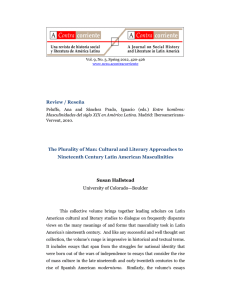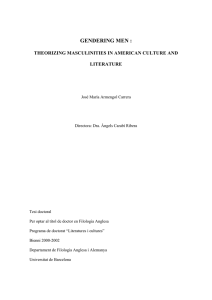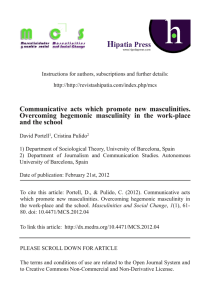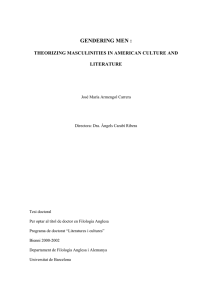"Male Perceptions of Intimacy: A Qualitative Study," Journal of Men`s
Anuncio
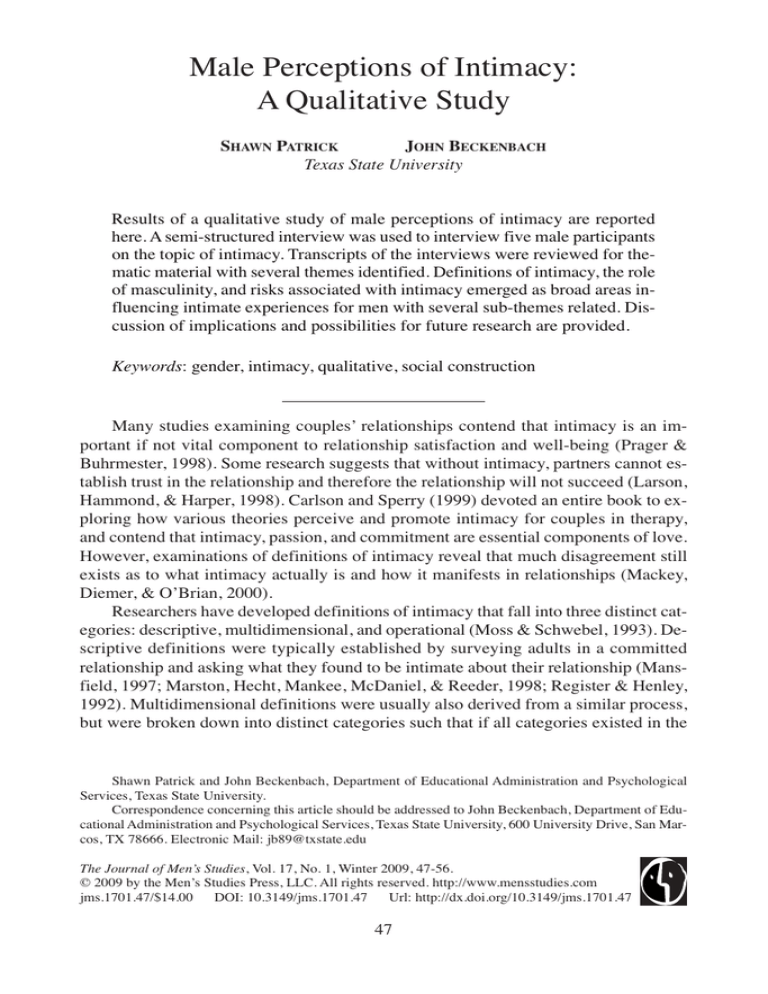
Male Perceptions of Intimacy: A Qualitative Study SHAWN PATRICK JOHN BECKENBACH Texas State University Results of a qualitative study of male perceptions of intimacy are reported here. A semi-structured interview was used to interview five male participants on the topic of intimacy. Transcripts of the interviews were reviewed for thematic material with several themes identified. Definitions of intimacy, the role of masculinity, and risks associated with intimacy emerged as broad areas influencing intimate experiences for men with several sub-themes related. Discussion of implications and possibilities for future research are provided. Keywords: gender, intimacy, qualitative, social construction Many studies examining couples’ relationships contend that intimacy is an important if not vital component to relationship satisfaction and well-being (Prager & Buhrmester, 1998). Some research suggests that without intimacy, partners cannot establish trust in the relationship and therefore the relationship will not succeed (Larson, Hammond, & Harper, 1998). Carlson and Sperry (1999) devoted an entire book to exploring how various theories perceive and promote intimacy for couples in therapy, and contend that intimacy, passion, and commitment are essential components of love. However, examinations of definitions of intimacy reveal that much disagreement still exists as to what intimacy actually is and how it manifests in relationships (Mackey, Diemer, & O’Brian, 2000). Researchers have developed definitions of intimacy that fall into three distinct categories: descriptive, multidimensional, and operational (Moss & Schwebel, 1993). Descriptive definitions were typically established by surveying adults in a committed relationship and asking what they found to be intimate about their relationship (Mansfield, 1997; Marston, Hecht, Mankee, McDaniel, & Reeder, 1998; Register & Henley, 1992). Multidimensional definitions were usually also derived from a similar process, but were broken down into distinct categories such that if all categories existed in the Shawn Patrick and John Beckenbach, Department of Educational Administration and Psychological Services, Texas State University. Correspondence concerning this article should be addressed to John Beckenbach, Department of Educational Administration and Psychological Services, Texas State University, 600 University Drive, San Marcos, TX 78666. Electronic Mail: jb89@txstate.edu The Journal of Men’s Studies, Vol. 17, No. 1, Winter 2009, 47-56. © 2009 by the Men’s Studies Press, LLC. All rights reserved. http://www.mensstudies.com jms.1701.47/$14.00 DOI: 10.3149/jms.1701.47 Url: http://dx.doi.org/10.3149/jms.1701.47 47 PATRICK AND BECKENBACH relationship, the relationship was considered to be “intimate” (Heller & Wood, 1998; Larson, Hammond, & Harper 1998; Prager, 1989; Schaefer & Olson, 1981; Waring, 1984; Wynne & Wynne, 1986). Operational definitions were obtained by observing behaviors that were linked to increasing or decreasing other factors in a relationship such as closeness, marital satisfaction, or self-disclosure (Prager, 1989; Prager & Buhrmester, 1998; Talmadge & Dabbs, 1990). Operational definitions assume that intimacy is synonymous with specific behaviors such as self-disclosure (e.g., Prager, 1989). According to Gaia (2002), descriptions of intimacy across all categories include: self-disclosure, emotional expression, support, trust, physical expression, feelings of closeness, and a mutual experience of intimacy. However, one problem with all of the above approaches is that intimacy has been defined from the perspective of the researcher, and not from the perspective of the participant (Monsour, 1992). In other words, participants in the above studies must select various terms or be categorized into areas that are pre-selected, which may influence a participant’s description of the intimate experience. Also when measuring intimacy, use of various scales can miss other components of the experience, providing a limited view of one’s true concept of intimacy. For example, Hook, Gerstein, Detterich, and Gridley (2003) found that when measuring intimacy, three scales instead of one were necessary in order to gain a multidimensional picture of intimacy. This meant that although all three scales claimed to measure intimacy, each scale by itself left out significant portions of the intimate experience, demonstrating that the scales were not measuring equivalent constructs as one might have originally assumed. Another factor that confounds results is how gender influences the perception and expression of intimacy. Heller and Wood (1998) attempted to study if gender affected perceptions of the relationship, and found that women tended to report higher feelings of intimacy in their relationships than their male counterparts. Women in general were also better able to predict their partner’s responses on an assessment instrument, and predicted those responses consistently. These results occurred even if the couple was found to have a low level of intimacy. Larson, Hammond, and Harper (1998) also attempted to incorporate an examination of gender into their study about the relationship between perceived equity and intimacy. Based on their results, they found that women perceived equity as an important factor for intimacy whereas men did not, although this result only occurred in couples where the husband and wife were of the same status (e.g., economically, socially, etc.). Wives who were of lower status in the relationship did not perceive equity as important to intimacy. The authors concluded this result demonstrated the impact of gender role socialization on perceptions of equity and intimacy. For example, because women have experienced a greater change in political power, they may view equity as more important to the relationship and thus more important for developing intimacy. Although these studies find differences between men and women’s description of intimacy and what each believe to be important in relationships, studies are not consistent regarding what the differences actually are. For example, it has largely been thought that men would experience intimacy through shared activity while women pre48 MALE PERCEPTIONS OF INTIMACY fer sharing intimacy through communication. Monsour (1992) in a study of same- and cross-sex friendships found instead that in cross-sex friendships, men included emotional expression and communication in their definitions of intimacy, and saw shared activity as an intimate experience more so in same-sex friendships. Self-disclosure was also important to both males and females in their concepts of intimacy. Also some studies find men communicate fewer feelings than women, and thus conclude that men do not express feelings or find feelings to be important in relationships (Gaia, 2002; Hook et al., 2003). However, Cordova, Gee, and Warren (2005) found that although men had difficulty expressing emotions, they did not have difficulty identifying them and valued intimate safety as much as women in relationships. They posed the possibility that men use means other than stating feelings in order to express and receive intimacy in their relationships. Related to these inconsistencies, some studies suggest that an inherent gender bias in the concept of intimacy may influence the subsequent results (Heller & Wood, 1998; Larson, Hammond, & Harper, 1998; Wynne & Wynne, 1986). These studies contend that definitions of intimacy include high levels of communication, affection, and closeness. However, when taking into account gender-role socialization, these characteristics tend to be exhibited more by women than by men as women are encouraged to focus more on relationship. Men socialized to focus more on task may, for example, complete a chore to demonstrate intimacy for their partner. Wynne and Wynne (1986) accuse the field of “feminizing” the term intimacy, such that possible masculine forms of showing intimacy may even be viewed as pathological. When examining gender-role socialization, authors such as Gilligan (1982) have discussed how men and women approach situations from different worldviews. For example, Gilligan states that women negotiate situations from a relational context, while men adopt an autonomous stance with others. Because men are encouraged to leave the home or “mother” earlier, they develop separate senses of themselves from others and seek independence. Women however are kept in closer relationship with others and are taught to identify themselves in terms of their relationships; therefore they interact with others based on an ethic of care. Because each gender may approach relationships differently, their views of intimacy may also differ. Theories related to the social construction of gender would also suggest that the process of generating “masculinity” could actually impede men from using methods of expression typically seen to be “feminine.” Social construction approaches contend that gender expectations are shaped and derived from societal forces of what is considered “normal,” and from these experiences we generate meaning as to who we are and how we are expected to behave. For example, Kimmel (2007) discusses how masculinity is defined to be the opposite of anything feminine, including “No sissy stuff” (p. 85). Thus if the expression of feeling has been normalized to the domain of women, expecting men to develop intimacy through such means could create considerable dissonance in their perception of self. Also, expecting men to describe their intimate experience using language that appears “feminine” could limit the ability to understand how men experience and engage in intimacy. 49 PATRICK AND BECKENBACH Few, if any, studies have focused solely on men’s perceptions of intimacy. Wagner-Raphael, Seal, and Ehrhardt (2001) interviewed several men on their experience of close relationships. Their study focused on friendships men have with other men and with women. Men who felt closer to women indicated that they found women easier to talk to than men, felt more comfortable with women, and could engage in sexual activity with women. Men who felt closer to men gave their primary reason as feeling as though they could relax and be themselves more in the presence of other men. These findings suggest that men are capable of forming close relationships that involve emotional experiences and communication, but their motivations and methods may not be the same as what women express. Because it seems crucial to understand intimacy from the perspective of the individual rather than imposed upon by the researcher, and that the construction of gender may influence how one conceptualizes intimacy, this study was developed to focus on men’s experience of intimacy in relation to the construction of masculinity. The purpose of this study was to examine intimacy solely from men’s perspectives in order to determine how men define their own intimate experiences. Since it is likely that the social construction of gender would influence one’s concept of intimacy, the relationship between intimacy and the construction of maleness was explored. This lead to two main research questions: how men define intimacy, and how men’s concept of intimacy is influenced by gender socialization. Method Participants Participants in this study were five Caucasian males who volunteered. These men ranged from 21 to 50 years. Two were married, two single, and one engaged. All indicated they were currently in a relationship they would describe as intimate. There were 4 volunteers that identified themselves as heterosexual and 1 that identified himself as gay; all participants indicated having relationships at some point with women. One of the participants was in undergraduate studies, one in graduate studies, and three were professionals. Procedure Recruitment took several forms. Flyers outlining the criteria for involvement and a brief description of the study were distributed in several public locations throughout a small southwestern city and on online bulletin boards. Further, the researchers visited college classrooms to present the details of the project and outline participation criteria. All recruitment materials directed potential participants to contact the principle investigators. At that time, potential participants were screened prior to scheduling interviews to insure that the participants understood the nature of the interview and were fit for the interview process. 50 MALE PERCEPTIONS OF INTIMACY Participants were interviewed using a semi-structured interview consisting of 14 open-ended, narrative-based questions. Narrative theory was utilized in the development of questions because this theory emphasizes allowing interviewees to create and expand on the meaning of personal stories. Thus narrative questioning would better approach the individual perspective rather than be constrained by interviewer bias. Also narrative interviewing approaches allow for externalization of the masculinity construct, which would aid in lowering possible defensiveness and easing discussion of an intangible element (White & Epston, 1990). The interviews were video taped and lasted approximately 2-3 hours. Utilizing the grounded theory qualitative approach, the interviews were then transcribed, coded, and examined for emerging themes by a team of five researchers consisting of four males and one female. Coders first individually identified emergent themes; then all came together as a group to discuss the themes identified individually. Discrepancies in themes were resolved through discussion and consensus. All identifying information was altered to protect participants’ confidentiality during this process. Results and Discussion Although the size of the sample was small, there was a great deal of consistency in the themes that emerged. Across all five interviews, three main categories were created: a global definition of intimacy, the influence of gender on views of intimacy, and risks associated with engaging in intimacy. Within these categories, substantial themes were revealed that demonstrated some consistency with previous research, but also generated interesting contradictions. Global Intimacy First, intimacy was described in several ways. It was described as an experience or emotion that is difficult to put into words; however actions meant to display intimacy were easier to describe. When initially asked to define intimacy, all participants stumbled over finding words to describe something they knew they had felt at some point in their relationships. In attaching intimacy to a feeling, most described it as a state of being or a momentary experience, something that one became aware of by noting when it was absent from a relationship. However, in attaching actions to intimacy, all participants could describe ways in which intimacy influenced how they related to their partners. One important action expressed in all interviews was sharing. Intimacy involved several levels of sharing, such as emotions, thoughts, words, and physical expressions. It is important to note that every participant had multiple levels of sharing, instead of one preferred form of sharing. This finding is similar to previous research indicating that expressiveness was important to men in relationships (Cordova, Gee, & Warren, 2005; Gaia, 2002) but also contradicts the notion that men are less interested in emotional or verbal sharing. For example, one man described his intimate experience as, 51 PATRICK AND BECKENBACH “When I feel safe, and when I intuitively know that they feel safe, and when we share whatever emotion is going on to whatever degree possible.” This statement reflects that sharing is reciprocal that generates safety and thus the desire to be as open as possible. This process suggests men have an interest in emotional expression with their partner, and in many ways a need to be emotionally seen. Sharing and exposing emotion also provides an avenue for increasing one’s awareness of self as noted in the following statement, “You find more about yourself as well. Because I think when you get intimate, you’re sharing yourself. In sharing yourself with someone, you learn about yourself.” Related to sharing, participants indicated that intimacy is a place where a man can be himself, including showing the worst parts of himself without fear of recrimination. This is similar to Wagner-Raphael, Seal, and Ehrhardt’s (2001) finding that closeness relates to being able to be himself in the presence of other men; however, men in the current study indicated that intimacy allows them to be themselves with their opposite-sex partners in a way that is different from being with other men. One participant put it as, “I don’t feel like I have to be different with the person. I don’t have to be fake with them.” Another expanded that this fakeness relates to having to put on certain “masks” around men, whereas with women, these masks were unnecessary, “[Intimacy] may just be honest, open communication with as many of your false selves shoved away.” Inherent in being oneself was the idea that the core person was also accepted by the other. This idea included that men were able to reveal parts of themselves that they were uncertain, scared, or ashamed of, without fear that they would be rejected for doing so. This process involved a level of vulnerability that these men did not express in other situations, thus suggesting the intimate relationship became a haven for letting down defenses. These men felt cared for, “[W]hen I’m being my worst self and that is still okay.” An atmosphere of trust was crucial for this exposure and acceptance to occur, which many indicated as one of the fears of becoming intimate. Trust established whether or not these men were willing to share and thus receive from their partners. Trust was also seen as a unique part of the intimate relationship; in other words trust between partners was different than trust among friends. Here trust seemed to indicate significance in that, “if you don’t have trust then you probably aren’t going to be anything to that person.” Thus it seemed that if men were going to risk exposure and possible rejection, they needed to know that exposure would be honored by the receiver and respected as a private event. “If [you’re partner] is being intimate with many other people or anyone besides yourself, then just how valuable are you to them?” This is consistent with other research about trust and intimacy (Gaia, 2002), but lends some insight into the process of trust for men. Sex also appeared as related to intimacy but with conflicting results. All men mentioned sex as something that marks an intimate relationship, but they differed on its level of significance. One man addressed how he thought the importance of sex had been exaggerated because of stereotypes about men, “… people in general have taught 52 MALE PERCEPTIONS OF INTIMACY that men only want one thing.” However, another respondent found sex to be a factor that could make or break a relationship, “bad sex can … potentially ruin a good relationship, and good sex can potentially sustain a bad relationship.” Also these men seemed to differentiate between having sex and experiencing intimacy with sex; in other words, sex could occur without intimacy but intimacy could not occur without some expression of physical affection. Physical affection that occurred in an atmosphere of intimate connection was also seen as a deeply emotional, connecting experience. This is consistent with findings that men more than women tend to value sex, but contradicts the stereotype that men find sex to be the same as intimacy (Monsour, 1992). Gender’s Influence on Intimacy The second category that emerged from these interviews related to how the social construction of masculinity influenced intimacy. Although at first many were uncertain how to respond to the question of how manhood relates to intimacy, all were able to speak to the roles they had been taught as men and how those roles influenced their interactions in relationships. Interestingly, all the participants conveyed their views of masculinity through telling stories about past relationships. Within these stories, men revealed their roles, fears, and expectations. This style is consistent with the idea that men convey significant experience through stories as opposed to direct statements of feeling (Brooks, 1998). The participants in this study emphasized that manhood embodied the roles of protector, rescuer, and anchor, summarized by one participant as, “It’s always assuming the most responsibility, because you are, as the man, whether you like it or not, you are the protector … she relies on you more for security than you rely on her.” Related to this description is the idea that men in heterosexual relationships view women as managing the internal aspects of the relationship while men secure the outer boundaries of the relationship. For example, one man stated, “I want to be there for her … help her out. Help her help us out.” In some ways this reflects the message that men save women first which thus preserves the integrity of the relationship. This idea is reflected in another description: In a dangerous situation, you would be the first to go in. And then you would bring her in if you needed to go … if there’s a fire in the room, you let her out first, and then you follow. You secure her safety first; you assume the most danger. The interviewees also indicated that masculinity is seen as a dominant position over the feminine, whether this be actual women or attributes seen as “feminine.” Being dominant related to holding the power in the relationship; “the reason I have that power is because my emotions aren’t engaged.” This relates to Kimmel’s (2007) concept that masculinity must reject the feminine; in other words, expression or use of emotion would somehow diminish a man’s position. Power also related to the expectation that men could act without having to justify or defend their position. Masculinity allowed 53 PATRICK AND BECKENBACH them to move freely in general and especially in intimate relationships, “You don’t have to [say], ‘I want to be the first one out the door because [italics added]’ … you just do it. We all agree that I should do it.” Interestingly, another respondent who had been involved in intimate relationships with men and women contrasted his role around the experience of power in that with women he could be in control, yet with men he could release his control: With men I’m not sure who’s [dominant] … I feel more like surrendering … I might lose my control here. Whereas I always felt in control with women and never had the fear that I was going to lose control. An additional theme identified was that manhood would not allow men to be vulnerable in the presence of other men. Vulnerability related to appearing “weak,” which seemed threatening for fear of how other men would discount the experience. Thus relationships with women became the only place where these men could express feelings or fears and experience safety and validation around the experience: “I think it’s more difficult for guys to share with one another, probably because there’s that constant insecurity of ‘damn, what’s he going to think of me—am I being a man?’” Expression of vulnerability thus was necessary in intimate relationships with women, even to the point where men seemed aware that they received this benefit likely more than they gave back. “But it always seems like the man gets the more healing than the woman … always tends to get more out of the relationship than the woman gets. The male is more wounded.” Overall men found themselves bound by the rules of masculinity, yet also recognized that this expectation often impeded the process and benefit of intimacy with women. This idea was summarized by one man’s discussion of how the “macho” image hurts the development of intimacy: … Men, manhood in general has a very strong stereotype of not allowing your emotions to [come out]. So I don’t think intimacy and men, manhood, go that well together. Since being raised that boys aren’t supposed to share their feelings … I think it’s through feminine input that intimacy is expressed through me. Risks Involved with Intimacy The third category identified in these interviews revolved around the potential risks of intimacy. These costs relate to the above ideas around vulnerability, that because they have become vulnerable and shared information that does not get shared publicly, intimacy poses great risk. The primary threat centered on the potential for being injured emotionally. This included fear of being judged or rejected by the other person, “… getting judged as not worthy; and when someone knows that much about you, it’s that much easier for them to hurt you … they can just twist the knife like no one else can.” This fear also extended beyond the immediate relationship to fears of retaliation or public humiliation, “if you severed a relationship and did so poorly, and they know 54 MALE PERCEPTIONS OF INTIMACY a lot about you, they can humiliate you.” These fears may also relate to why men described intimacy as a private, almost sacred experience that needed to be shared with only one other person who could hold that trust. When examining these three categories, intimacy is linked to perception of one’s role in the relationship, involves being accepted, free to be oneself, and reciprocal sharing of several aspects including communication, sex, and activity. These experiences are difficult to divorce from how one is socialized into being “masculine,” thus indicating that social construction must be taken into account when examining experiences of intimacy. Interestingly all men in this study expressed desire and need for intimacy and could articulate how masculine expectations influenced that process. Men tended to view intimacy as a necessary space that they could visit and relieve themselves of the burdens of masculinity, yet also expressed no desire to stop “being male.” In other words, men wanted time and a place to become vulnerable, but did not want to have to “act like women” in order to do so. Implications and Directions for Future Research This study was exploratory in nature and several key ideas emerged. Continuing to examine the relationship between social construction of masculinity and its effects on intimacy appears to be an important part of understanding how men experience and conceive of intimacy. Contrary to stereotypes about men, both men and women do desire intimacy, although both may think of intimacy differently. Rather than suggesting men and women enact only one set of skills for increasing intimacy, exploration of each person’s perspective about what intimacy involves and requires is essential for relationship development. Further, mental health practitioners working with men and couples need to include in their practice awareness of how social construction of gender will influence concepts of identity that play out in romantic relationships. Greater investigation of these areas will be necessary to the process of creating change that respects each person’s worldview. As mentioned, current assessments of intimacy tend to feminize the concept (Hook et al., 2003; Monsour, 1992), thus caution should be employed when using an instrument to measure the level of intimacy experienced or expressed by men. It is possible men’s level of intimacy appears less because the instruments are not capturing the most salient aspects of their experience. Future studies clarifying how men and women approach intimacy are needed; this study could be replicated with a larger number of interviewees or focusing on one aspect of the themes mentioned. It would be interesting to interview couples on how they generated intimacy in relation to the construction of gender roles and expectations. Intimacy can also be examined in relation to the construction of other factors such as ethnicity or sexuality. Also this study only focused on romantic relationships; other studies examining other types of intimate experience for men, such as friendships or fatherhood, could be developed. 55 PATRICK AND BECKENBACH References Brooks, G. (1998). A new psychotherapy for traditional men. San Francisco: Jossey-Bass. Carlson, J., & Sperry, L. (1999). Introduction: A context for thinking about intimacy. In J. Carlson & L. Sperry (Eds.), The intimate couple (pp. 3-6). Philadelphia, PA: Brunner/Mazel. Cordova, J., Gee, C., & Warren, L. (2005). Emotional skillfulness in marriage: Intimacy as a mediator of the relationship between emotional skillfulness and marital satisfaction. Journal of Social and Clinical Psychology, 24(2), 218-235. Gaia, C. (2002). Understanding emotional intimacy: A review of conceptualization, assessment and the role of gender. International Social Science Review, 77(3-4), 151-170. Gilligan, C. (1982). In a different voice. Cambridge, MA: Harvard University Press. Heller, P. E., & Wood, B. (1998). The process of understanding intimacy: Similarity, understanding, and gender. Journal of Marital and Family Therapy, 24(3), 273-288. Hook, M., Gerstein, L., Detterich, L., & Gridley, B. (2003). How close are we? Measuring intimacy and examining gender differences. Journal of Counseling and Development, 81, 462472. Kimmel, M. (2007). Masculinity as homophobia: Fear, shame, and silence in the construction of gender identity. In P. Rothenberg (Ed.), Race, class, and gender in the United States (7th ed., pp. 80-92). New York: Worth. Larson, J. H., Hammond, C. H., & Harper, J. M. (1998). Perceived equity and intimacy in marriage. Journal of Marital and Family Therapy, 24(4), 487-506. Mackey, R., Diemer, M., & O’Brian, B. (2000). Psychological intimacy in the lasting relationships of heterosexual and same-gender couples. Sex Roles, 43(3/4), 201-227. Mansfield, P. (1997). Intimacy in the 1990’s? Sexual and Marital Therapy, 12(3), 205-210. Monsour, M. (1992). Meanings of intimacy in cross- and same-sex friendships. Journal of Social and Personal Relationships, 9, 277-295. Moss, B. F., & Schwebel, A. I. (1993). Defining intimacy in romantic relationships. Family Relations, 42, 31-37. Marston, P. J., Hecht, M. L., Manke, M. L., McDaniel, S., & Reeder, H. (1998). The subjective experience of intimacy, passion, and commitment in heterosexual loving relationships. Personal Relationships, 5, 15-29. Prager, K. (1989). Intimacy status and couple communication. Journal of Social and Personal Relationships, 6, 435-449. Prager, K. J., & Buhrmester, D. (1998). Intimacy and need fulfillment in couple relationships. Journal of Social and Personal Relationships, 15(4), 435-469. Register, L. M., & Henley, T. B. (1992). The phenomenology of intimacy. Journal of Social and Personal Relationships, 9, 467-481. Schaefer, M. T., & Olson, D. H. (1981). Assessing intimacy: The pair inventory. Journal of Marital and Family Therapy, 7, 47-60. Talmadge, L. D., & Dabbs, J. M. (1990). Intimacy, conversational patterns, and concomitant cognitive/emotional processes in couples. Journal of Social and Clinical Psychology, 9(4), 473-488. Wagner-Raphael, L., Seal, D., & Ehrhardt, A. (2001). Close emotional relationships with women versus men: A qualitative study of 56 heterosexual men living in an inner-city neighborhood. The Journal of Men’s Studies, 9(2), 243-256. Waring, E. (1984). The measurement of marital intimacy. Journal of Marital and Family Therapy, 10(2), 185-192. White, M., & Epston, D. (1990). Narrative means to therapeutic ends. New York: W.W. Norton. Wynne, L. C., & Wynne, A. R. (1986). The quest for intimacy. Journal of Marital and Family Therapy, 12(4), 383-394. 56
